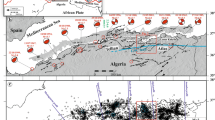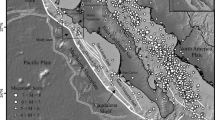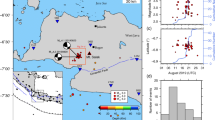Abstract
Recent seismic activity in southern Lebanon is of particular interest since the tectonic framework of this region is poorly understood. In addition, seismicity in this region is very infrequent compared with the Roum fault to the east, which is seismically active. Between early 2008 and the end of 2010, intense seismic activity occurred in the area. This was manifested by several swarm-like sequences and continuous trickling seismicity over many days, amounting in total to more than 900 earthquakes in the magnitude range of 0.5 ≤ M d ≤ 5.2. The region of activity extended in a 40-km long zone mainly in a N-S direction and was located about 10 km west of the Roum fault. The largest earthquake, with a duration magnitude of M d = 5.2, occurred on February 15, 2008, and was located at 33.327° N, 35.406° E at a depth of 3 km. The mean-horizontal peak ground acceleration observed at two nearby accelerometers exceeded 0.05 g, where the strongest peak horizontal acceleration was 55 cm/s2 at about 20 km SE of the epicenter. Application of the HypoDD algorithm yielded a pronounced N-S zone, parallel to the Roum fault, which was not known to be seismically active. Focal mechanism, based on full waveform inversion and the directivity effect of the strongest earthquake, suggests left-lateral strike-slip NNW-SSE faulting that crosses the NE-SW traverse faults in southern Lebanon.













Similar content being viewed by others
References
Aki A (1965) Maximum likelihood estimate of b in the formula logN = a-bM and its confidence limits. Bull Earthq Res Inst Tokyo 43:237–239
Arieh E (1967) Seismicity of Israel and adjacent areas. Geol Surv Isr Bull 43:1–4
Bakun WH (1984) Seismic moments, local magnitudes, and coda-duration magnitudes for earthquakes in central California. Bull Seis Soc Am 74:439–458
Ben-Avraham Z, Ginzburg A, Makris J, Eppelbaum L (2002) Crustal structure of the Levant basin, eastern Mediterranean. Tectonophysics 346:23–43
Ben-Menahem A, Aboodi E (1981) Micro- and macroseismicity of the Dead Sea rift and off-coast eastern Mediterranean. Tectonophysics 80:199–233
Brune JN (1970) Tectonic stress and the spectra of seismic shear waves from earthquakes. J Geophys Res 75:4997–5009
Brune JN (1971) Correction. J Geophys Res 76:5002
Brune JN, Allen CR (1967) A low-stress-drop, low-magnitude earthquake with surface faulting: the Imperial, California, earthquake of March 4, 1966. Bull Seis Soc Am 57:501–514
Carton H, Singh SC, Elias A, Tapponnier P, Briais A, Sursock A, Jomaa R, Daeron M, King G, Jacques E (2004) Miocene to Quaternary folding and thrusting offshore Lebanon from SHALIMAR seismic profiles. EOS Trans., AGU, abs. 0488
Daeron M, Benedetti L, Tapponnier P, Sursock A, Finkel RC (2004) Constraints on the post 25-ka slip rate of the Yammouneh fault (Lebanon) using in situ cosmogenic 36Cl dating of offset limestone-class fans. Earth Planet Sci Lett 227:105–119
Dreger D, Helmberger D (1993) Determination of source parameters at regional distances with three-component sparse network data. J Geophys Res 98:8107–8125
Forsyth DW, Yang Y, Mangriotis MD, Shen Y (2003) Coupled seismic slip on adjacent oceanic transform faults. Geophys Res Lett 30:1618. doi:10.1029/2002GL016454
Ginzburg A, Ben Avraham Z (1987) The deep structure of the central and southern Levant continental margin. Annals Tectonicae 1:105–115
Gitterman Y, Pinsky V, Shapira A, Ergin M, Gurbuz C, Solomi K 2005 Improvement in detection, location and identification of small events through joint data analysis by seismic observations in the Middle East/Eastern Mediterranean Region, Final Report DTRA01-00-C-0119, DOD USA
Hanks TC, Boore DM (1984) Moment-magnitude relations in theory and practice. J Geophys Res 89:6229–6235
Hanks TC, Thatcher W (1972) A graphical representation of seismic source parameters. J Geophys Res 77:4393–4405
Hofstetter A (2003) Seismic observations of the 22/11/1995 Gulf of Aqaba earthquake sequence. Tectonophysics 369:21–36
Hofstetter A, Shapira A (2000) Determination of earthquake energy release in the Eastern Mediterranean region. Geophys J Int 143:1–16
Hofstetter A, van Eck T, Shapira A (1996) Seismic activity along fault branches of the Dead Sea-Jordan transform system: the Carmel-Tirtza fault system. Tectonophysics 267:317–330
Hofstetter R, Gitterman Y, Pinsky V, Kraeva N, Feldman L (2008) Seismological observations of the Northern Dead Sea Basin earthquake on 11/2/2004 and its associated activity. Isr J Earth Sci 57:101–124
Johnson CE, Hadley DM (1976) Tectonic implications of the Brawley earthquake swarm, Imperial Valley, California, January 1975. Bull Seis Soc Am 66:1133–1144
Kanamori H, Anderson D (1975) Theoretical basis of some empirical relations in seismology. Bull Seis Soc Amer 65:1073–1095
Kanamori H, Rivera L (2004) Static and dynamic scaling relations for earthquakes and their implications for rupture speed and stress drop. Bull Seis Soc Amer 94:314–319
Khair K (2001) Geomorphology and seismicity of the Roum faults one of the active branches of the Dead Sea fault system in Lebanon. J Geophys Res 106:4233–4245
Malagnini L, Mayeda K (2008) High-stress strike-slip faults in the Apennines: an example from the 2002 San Giuliano earthquakes (southern Italy). Geophys Res Lett 35:L12302. doi:10.1029/2008GL034024
Mayeda K, Malagnini L, Walter W (2007) A new spectral ratio method using narrow band coda envelopes: evidence for non-self-similarity in the Hector Mine sequence. Geophys Res Lett 14:11303–11308
Nemer T, Meghraoui M (2006) Evidence of coseismic ruptures along the Roum fault (Lebanon): a possible source for the AD 1837 earthquake. J Struc Geol 28:1483–1495
Omori F (1894) On aftershocks of earthquakes. J College Sci Imperial Univ Tokyo 7:111–200
Rabinowitz N, Steinberg D (1998) Aftershock decay of three strong earthquakes in the Levant. Bull Seis Soc Amer 88:1580–1587
Roland E, McGuire JJ (2009) Earthquake swarms on transform faults. Geophys J Int. doi:10.1111/j.1365-246X.2009.04214.x
Ron H (1987) Deformation along the Yammouneh, the restraining bend of the Dead Sea transform: Paleomagnetic data and kinematic implications. Tectonics 6:653–666
Salamon A, Hofstetter A, Garfunkel Z, Ron H (1996) Seismicity of Eastern Mediterranean Region: perspective from the Sinai subplate. Tectonophysics 263:293–305
Schattner U, Ben Avaraham A, Lazar M, Hübscher C (2006) Tectonic isolation of the Levant basin offshore Galilee-Lebanon—effects of the Dead Sea fault plate boundary on the Levant continental margin, Eastern Mediterranean. J Structural Geol 28:2049–2066
Shapira A (1991) Detectability of regional seismic networks: analysis of the Israel seismic networks. Isr J Earth Sci 41:21–25
Shapira A, Feldman L (1987) Microseismicity of three locations along the Jordan rift. Tectonophysics 141:89–94
Shapira A, Gitterman Y (1995) Evaluation of detectability of the Israel Seismograph Network. IPRG Rep. D16/101/94(2), in Hebrew
Shapira A, Hofstetter A (1993) Sources parameters and scaling relationships of the earthquakes in Israel. Tectonophysics 217:217–226
Shapira A, Hofstetter A (2001) Seismicity parameters of seismogenic zones, Appendix C, in Updated map of maximal acceleration in the Israel Building Code, by Shapira, A., http://www.seis.mni.gov.il/heb/Teken/report_413.htm
Thatcher W, Hanks T (1973) Source parameters of southern California earthquakes. J Geophys Res 78:8547–8576
Utsu T, Ogata Y, Matsu'ura S (1995) The centenary of the Omori formula for a decay law of aftershock activity. J Phys Earth 43:1–33
Van Eck T, Hofstetter A (1989) Microearthquake activity in Dead Sea region. Geophys J Int 99:605–620
Vidale JE, Shearer PM (2006) A survey of 71 earthquake bursts across southern California: exploring the role of pore fluid pressure fluctuations and a seismic slip as drivers. J Geophys Res 111:B05312. doi:10.1029/2005JB004034
Waldhauser F, Ellsworth WL (2000) A double-difference earthquake location algorithm: method and application to the northern Hayward fault, California. Bull Seism Soc Am 90:1353–1368
Walley CD (1988) A braided strike-slip model for the northern continuation of the Dead Sea Fault and its implications for Levantine tectonics. Tectonophysics 145:63–72
Walley CD (1998) Someoutstanding issues in the geology of Lebanon and their importance in the tectonic evolution of the Levantine region. Tectonophysics 298:37–62
Wessel P, Smith W (1991) Free software helps maps and display data. EOS Trans AGU 72:441
Wiechert D (1980) Estimation of the earthquake recurrence parameters for unequal observation periods for different magnitudes. Bull Seis Soc Amer 70:1337–1346
Acknowledgements
D. Kadosh, D. Levi, and U. Peled kept the ISN operating. L. Feldman and B. Reich did the initial data processing. We are grateful to S. Marco, U. Schattner, and M. Lazar for constructive comments that improved the manuscript. Some figures in this report were prepared using the GMT program (Wessel and Smith 1991).
Author information
Authors and Affiliations
Corresponding author
Rights and permissions
About this article
Cite this article
Meirova, T., Hofstetter, R. Observations of seismic activity in Southern Lebanon. J Seismol 17, 629–644 (2013). https://doi.org/10.1007/s10950-012-9343-2
Received:
Accepted:
Published:
Issue Date:
DOI: https://doi.org/10.1007/s10950-012-9343-2




